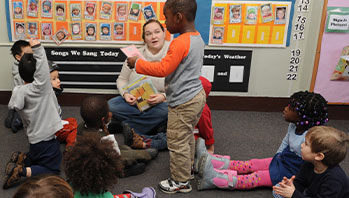- rhyme
- sound
MA Standards:
Foundational Skills/RF.PK.MA.2.a: With guidance and support, recognize and produce rhyming words (e.g., identify words that rhyme with /cat/ such as /bat/ and /sat/).
Head Start Outcomes:
Literacy Knowledge/Phonological Awareness: Identifies and discriminates between sounds and phonemes in language, such as attention to beginning and ending sounds of words and recognition that different words begin or end with the same sound.
PreK Learning Guidelines:
English Language Arts/Reading and Literature 8: Listen to, identify, and manipulate language sounds to develop auditory discrimination and phonemic awareness.
Word Play: Rhyming Words #2

© Commonwealth of Massachusetts, Department of Early Education and Care (Jennifer Waddell photographer). All rights reserved.
ELA Focus Skills: Phonological Awareness, Speaking and Listening, Vocabulary
Reread City Lullaby by Marilyn Singer to children. For this read, focus on the rhyming words in the text.
- Tell children you are going to reread parts of the book.
- Explain that this time you are not going to focus on all the noisy sounds in the story; instead you want them to listen carefully to the words. Encourage them to listen to the last word of each line. Stress the rhyming words as you read.
Read the two following sentences and then repeat the words beeping and sleeping. Remind children that when the ends of words sound the same, the words rhyme.
Traffic jam, 10 horns beeping.
In the stroller, Baby’s sleeping.
- Give a few more examples of rhyming words to reinforce the concept: beep, sleep; ling, ring; park bark.
- Continue reading City Lullaby two lines at a time and pause and ask children to identify the rhyming words.
Take It Further: Reread the rhyming text, pausing before the second rhyming word, and encouraging the kids to fill in the rhyming word. Encourage them to insert different rhyming words as well.
Educator Tip: Guided and independent letter, sound, and word practice continues to take place in center activities. It is helpful to set up the literacy center immediately after the direct instruction and repeat instruction before children work in the literacy center identifying letters.
